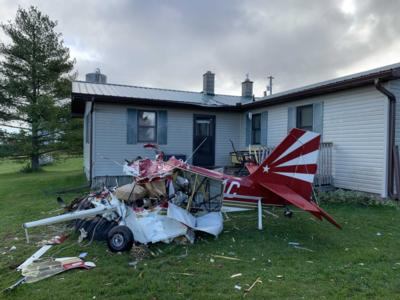Airplane Impacted The Ground During The Descent Portion Of The Loop
Location: Marengo, WI Accident Number: CEN22FA019
Date & Time: October 23, 2021, 14:40 Local Registration: N843AC
Aircraft: American Champion Aircraft 8KCAB Injuries: 2 Fatal
Flight Conducted Under: Part 91: General aviation - Personal

On October 23, 2021, about 1440 central daylight time, an American Champion Aircraft 8KCAB airplane, N843AC, was destroyed when it was involved in an accident near Marengo, Wisconsin. The pilot and his passenger were fatally injured. The airplane was operated as a Title 14 Code of Federal Regulations Part 91 personal flight.
The pilot’s sister-in-law reported that she received a phone call from the pilot about 5 minutes before the accident, and that the pilot told her to wait outside because he intended to fly over her house. The airplane overflew her position multiple times at a low altitude before it entered an aerodynamic loop maneuver. The airplane impacted a house and terrain while descending in the loop maneuver.
Another witness reported seeing the airplane flying “pretty low” before it entered an aerobatic loop maneuver on a north heading. The airplane was inverted at top of the loop on a south heading before it descended toward the ground on a north heading. The airplane impacted the ground during the descent portion of the loop.
An onsite examination determined the airplane’s right wing leading edge impacted the roof of a house before the fuselage impacted the ground in a nose-down pitch attitude. The main wreckage came to rest in the back yard of the house on a north heading. The main wreckage consisted of the fuselage, empennage, engine, and propeller. Both wings separated from the upper fuselage during impact and were found about 20 ft north of the main wreckage. Flight control cable continuity could not be established; however, all observed separations were consistent with impact related damage.

The engine remained attached to the fuselage, and the propeller remained partially attached to the engine crankshaft. One propeller blade exhibited compound bending; opposite rotation, aft, and twisted toward low pitch. The other propeller blade mostly exhibited aft bending. Both propeller blades exhibited chordwise/rotational scoring and leading edge gouging.
The engine did not exhibit any crankcase or cylinder fractures. The upper sparkplugs exhibited features consistent with normal engine operation. Internal engine and valve train continuity were confirmed as the engine crankshaft was rotated through the propeller governor drive gear. Compression and suction were noted on all four cylinders in conjunction with crankshaft rotation. Both magnetos provided spark at each post when rotated by hand. Fuel was observed in the electric fuel pump, engine-driven fuel pump, fuel servo, and the fuel line to the fuel manifold valve. The engine examination revealed no evidence of a mechanical malfunction or failure that would have precluded normal operation.
A review of the sound spectrum that was extracted from a short video clip recorded in moments before the accident determined the fundamental propeller blade passage was about 80Hz, which corresponded to 2,400 rpm for the 2-blade propeller. The postaccident examination revealed no evidence of a mechanical malfunction or failure that would have precluded normal operation of the airplane.
 ANN's Daily Aero-Term (05.05.24): Omnidirectional Approach Lighting System
ANN's Daily Aero-Term (05.05.24): Omnidirectional Approach Lighting System Aero-News: Quote of the Day (05.05.24)
Aero-News: Quote of the Day (05.05.24) Airborne 05.06.24: Gone West-Dick Rutan, ICON BK Update, SpaceX EVA Suit
Airborne 05.06.24: Gone West-Dick Rutan, ICON BK Update, SpaceX EVA Suit Airborne 05.03.24: Advanced Powerplant Solutions, PRA Runway Woes, Drone Racing
Airborne 05.03.24: Advanced Powerplant Solutions, PRA Runway Woes, Drone Racing Aero-News: Quote of the Day (05.06xx.24)
Aero-News: Quote of the Day (05.06xx.24)




